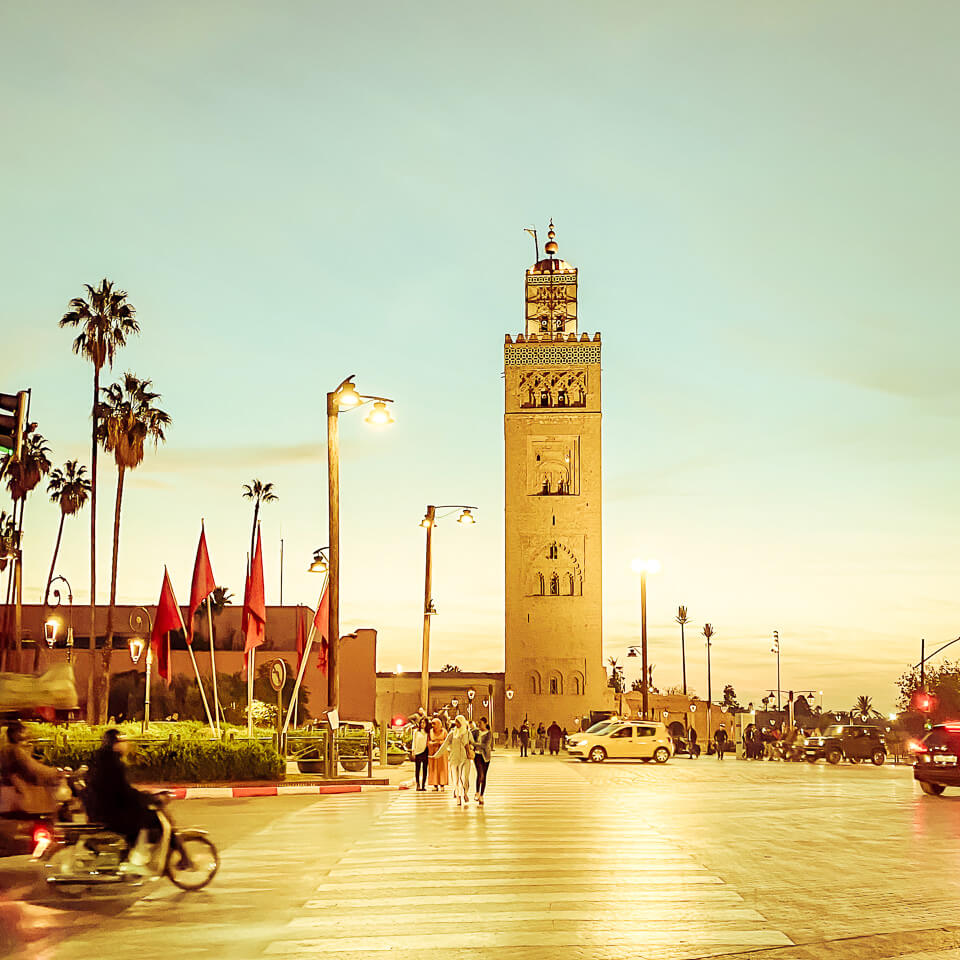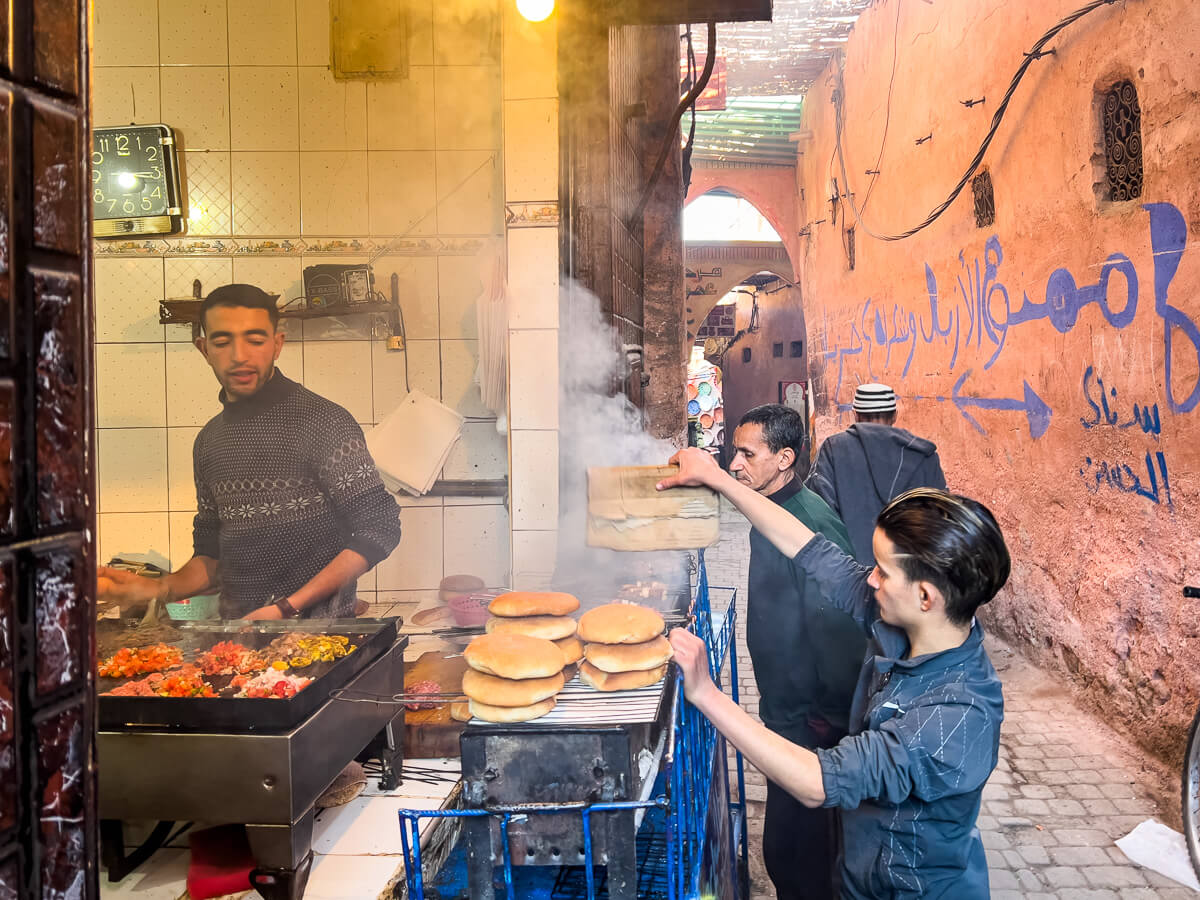Marrakesh is a culinary paradise. Moroccan cuisine is rightly world-famous, because the aromatic, stewed tagines and salades marocaines are unique. But don’t stop at tagines and couscous, because there is so much more to discover!
A snack from a street stall can also be a culinary treat and is an essential part of a visit to Marrakesh. Countless kitchens line the alleyways and the smell of grilled food wafts through the souk.
But what is on offer? What is all this? Does it taste good? Can you eat it without intestinal problems ruining your vacation afterwards? What is lamb mechoui and where can you get the best tangia?
Find the answers in this guide to street food in Marrakesh! We present the best places where you can get a quick bite to eat.
If you are looking for a cozy place to eat: Good restaurants with great roof terraces and dreamy courtyards can be discovered in our blog post The best restaurants in the medina of Marrakesh.
The best way to book a guided food tour is via GetYourGuide, e.g. the Guided Street Food Walk and Taste Tour*.
Affiliate links: The links marked with an asterisk (*) are referral links, also known as affiliate links. This means that if you buy something via such a link, we receive a small commission. There are no additional costs for you, but with your purchase you help us to continue creating useful content for travelers. Enjoy our stories and “Shukran” for your support!
Hygiene
In general, you can eat at street vendors and snack bars without any problems. Hotels, restaurants and snack bars must adhere to certain hygiene standards and are regularly inspected. The Moroccan government is well aware that in times of online portals such as Tripadvisor and the like, bad reports about hygiene problems are damaging tourism, and is reacting accordingly.
Nevertheless, the following also applies here: it doesn’t hurt to take a look at the cleanliness of the counter or even the kitchen. Your gut feeling is important — if you are unsure, don’t do it. There are plenty of alternatives.
However, you shouldn’t always be put off by outward appearances — the food can be absolutely delicious despite simple tin plates, a scratched tablecloth and a piece of paper instead of a napkin!
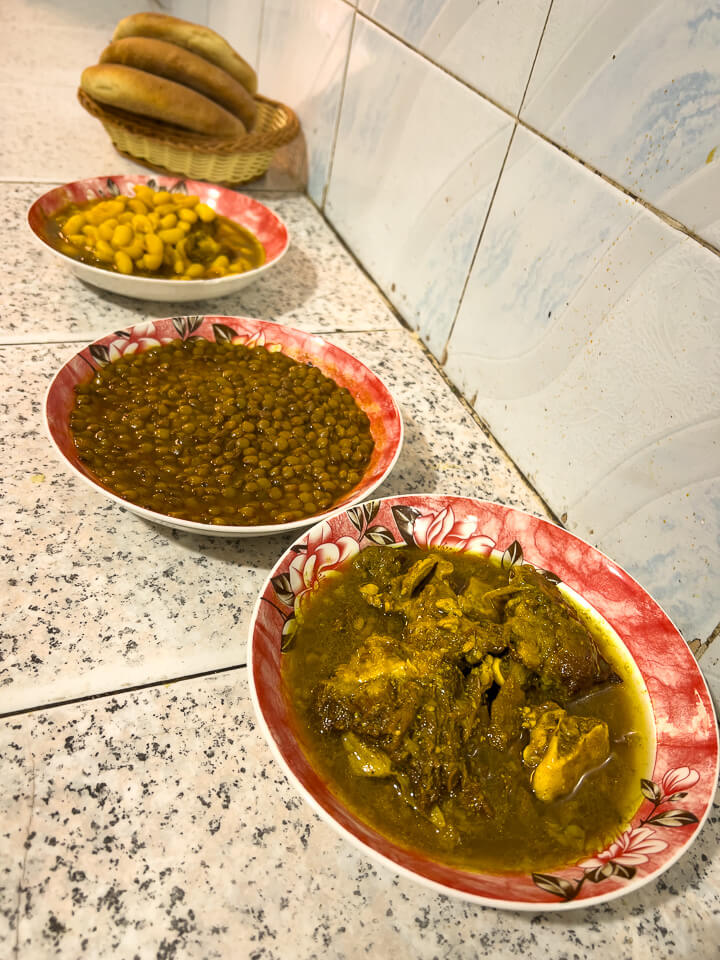
Drinks — water, tea and fruit juices
Water
Walking around the souk makes you thirsty, especially when it’s hot. This makes it difficult to drink enough water every day. But it’s not really a problem, because bottled water and other drinks can be bought in many places in the souk, usually at moderate prices and well chilled.
Disposing of the bottle is more of a problem. There are only public garbage cans at Jemaa el Fna. Sometimes there are garbage cans at the snack bars or kiosks, sometimes at tourist points of interest such as ATMs or tourist attractions. Otherwise it’s a case of: Carry the bottle around with you and dispose of it at the hotel or when visiting a restaurant.
Mint tea
If your feet need a break, find a small café and drink a mint tea. You can’t go wrong with that, fresh mint tea is always good. I always order a bottle of water with it, as the tea is usually sweet and doesn’t really quench your thirst. You can also use the toilet in the café, as public toilets are few and far between and I haven’t yet found one that I would have liked to use.
Fruit juices

There are a number of juice stalls on the Jemaa el Fna where you can get incredibly tasty juice.
You can drink it without any problems, but you should order the juice without ice cubes and make sure the plastic cups are new and clean beforehand.
Fresh juices are also sometimes available in small snack bars and street vendors. The same applies here: no ice cubes and check the plastic cups first.
When in season, pomegranates are piled up on mobile carts all over the city, from which pomegranate juice is pressed on the spot. It tastes delicious. The vendors don’t have any ice anyway and if the plastic cups look new, there’s nothing to stop you enjoying it.
Sugar cane juice is just as seasonal. A lot of sugar cane is grown in Morocco and mobile juice presses are a common sight in the city. The juice is delicious, but pure sugar and therefore really sweet.
Coffee
Small coffee shops serving espresso, latte macchiato or Moroccan coffee with spices can be found all over the medina. Some stores have adapted to the needs of tourists and serve soy, oat or almond milk with their coffee alongside the classics.
Our favorite coffee shop is Kech’Cup, located on a corner near the Jardin Secret. You can’t miss it because of its bright green color, and the best espresso is served here. There are 3 stools in the tiny store, it’s always full and the barista knows his business!

If you come across a stand that prepares coffee in the sand, you should definitely try it:
Under the Sahara sand is a gas cylinder that heats the sand to around 80 degrees Celsius, in which the coffee pot is then heated until the coffee is thick and frothy.
Thanks to the gentle preparation, the coffee is creamy and velvety and not a bit bitter. Very, very tasty!
Mobile sales stands
In the wider alleyways in the souk and the medina, there are always mobile stalls, so-called charettes, offering seasonal produce. Here you can buy freshly harvested fruit and vegetables, usually charged by weight.
The fruit tastes much better than here. It is sweeter and riper and always fresh.
The carts arrive fully loaded in the morning in the medina, move around and are bought empty a few hours later.

If you buy something from the charettes, the stalls on wheels, make sure you wash the fruit before eating it if necessary. With bottled water of course, not the water from the hotel tap.
The small bananas grown in Morocco are very tasty. If it is strawberry season, you will find mountains of delicious red strawberries, which are sold by the kilo.

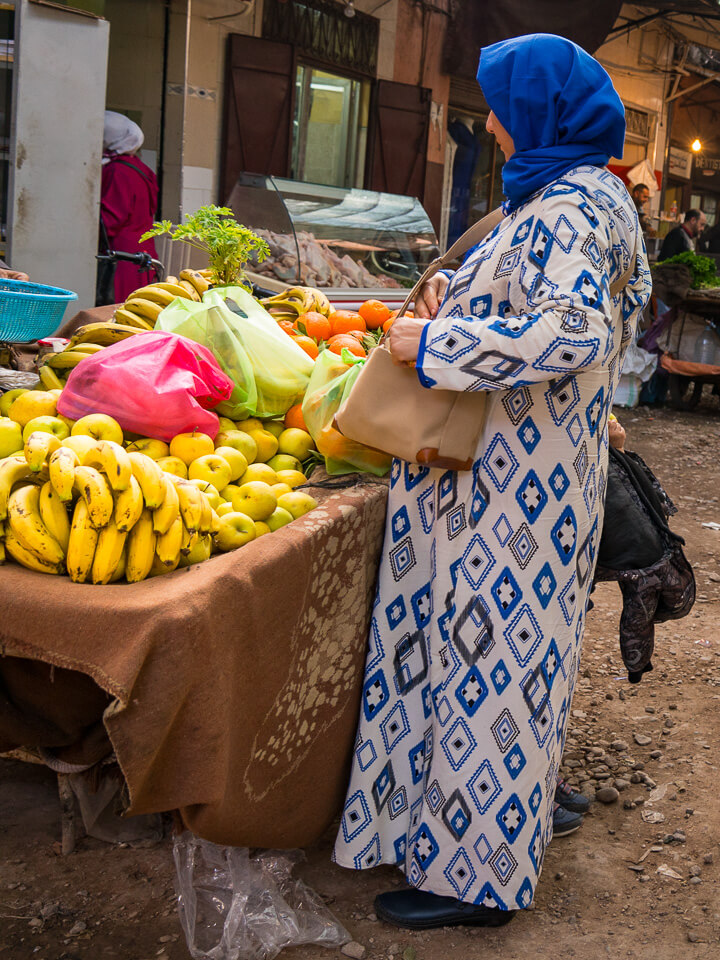
In summer, there are sugar-sweet melons and once you’ve tried a Moroccan watermelon, you will be spoiled. My son is watermelon fan and he always makes sure that our vacation plans coincide with watermelon season! But be careful: too much watermelon can also have negative consequences for the gut.
The avocados, starting from October, are incredibly tasty. Persimmons are available in the fall, as are sweet grapes. November is tangerine and orange season.
Prickly pears are also ripe in the fall and are sold in heaps throughout the city. The vendor cuts them open on the spot, you pick out the inside with a toothpick and enjoy. This way you are guaranteed not to come into contact with the spines. The dark purple flesh tastes tart and sweet at the same time and is a real superfood.
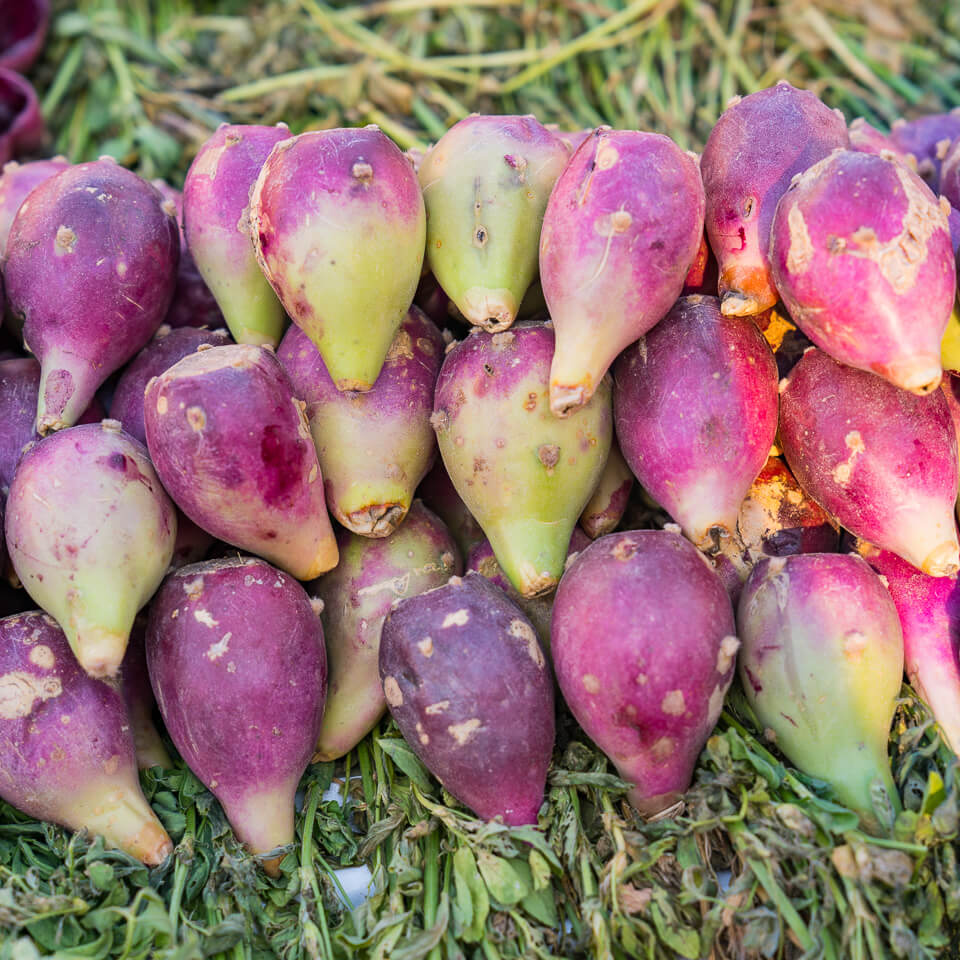

Afterwards, your tongue is just as pink as your lips. You should definitely try prickly pears if you are not familiar with them, as you can hardly ever buy them in central Europe.
Of course, there are also seasonal vegetables, which are just as delicious as the fruit, but as a hotel guest you can usually do little with them.
With a loaf of bread, a few olives, an avocado and some fruit, you could have a wonderful picnic at lunchtime. Unfortunately, it’s not that easy, as there are no public green spaces for a picnic in the medina. Even at Jemaa el Fna there are hardly any places to sit. You are most likely to find something around the Koutoubia Mosque.
Markets and market halls
Medina markets
There are smaller markets in various corners of the medina. We like to buy our fruit and vegetables at Bab Doukkala. There is a mixture of stores and market stalls in the wide alleyway and the hustle and bustle is characterized by locals who buy their groceries there.
The market stalls sell vegetables, fruit and herbs, and there are also butchers and fishmongers. The stores sell everyday items such as soap, cat food and cell phone cards, as well as olives, dates and nuts.

Market Halls
While the markets mostly offer fresh produce, the market halls also have meat and fish, including the strong smell that goes with it. The market hall on Place des Ferblantiers in the south of the medina is only for people with strong nerves, especially the corner where the chickens are slaughtered. In the Moroccan heat, customers want to be sure that the meat is fresh!
So if you are curious, I can only recommend a visit to a market hall — it could hardly be more authentic.
Small vendors make up the majority of street food in Marrakesh
Food is sold on every corner in the medina, sometimes on a mobile stall, sometimes in a real store. The vendor usually focuses on one specialty and when he is sold out, he makes room for the rest of the day. It is therefore rarely possible to predict exactly where you will get what, and you have to grab it when the opportunity presents itself.
Briouats are triangular filled dumplings that are sometimes sold in the souk. They are filled with chicken, cheese or vegetables and taste delicious. If you want to eat something hearty quickly, which is very tasty and doesn’t cost much, briouats are just the thing.
Chickpeas, nuts and olives
Roasted chichpeas are in Marrakesh what potato potato chips are to us. Lightly salted, sometimes spiced, crispy, crunchy, irresistibly delicious. The chickpeas are freshly roasted by traders in mobile stalls and sold while still warm, similar to our chestnut traders in winter. Or you can find the chickpeas at the traders who sell nuts and dates, not freshly roasted, but also very tasty.
Almonds, peanuts and other nuts can be bought openly from traders whose tiny stores are hidden among all the other stores. You are usually allowed to try what you like beforehand and are charged by weight. If the trader only speaks Arabic, the owner of the store next door translates or the price is indicated with hands and feet. Nobody has to go hungry in Morocco because of language difficulties.


Behind the Jemaa el Fna there is an area where all the olive merchants are located. Here, visitors are spoiled for choice between the countless vendors, who basically all offer the same thing: Olives in all possible variations.
The traders are happy to let you taste the olives and the goods are charged by weight. The olives are not expensive and there are many delicious varieties to discover.
You can also buy the typical Moroccan preserved lemons, the citrons confits, here. You should let the vendor know if you want to take the olives or lemons home with you, then maybe he will pack them in a plastic box, not in a plastic bag.
Bread fresh from the oven

Flatbread is available fresh from the countless small bakeries that can be found in many places in the medina. Right at the beginning of the alleyway Derb Tizougarine, where our Riad Selouane is located, there is a bakery that bakes fresh bread all day long. The first batch is baked at 6 in the morning and the bakery is cleaned and closed at midnight.
You can buy a loaf of bread for a few dirhams and there is hardly anything tastier than a warm flatbread straight from the wood-fired oven.
Incidentally, the ovens are fired with the waste from the wood carvers who work all over the souk. Moroccan recycling, so to speak.

Looking for a hotel in Marrakesh?
The best location in the medina, breakfast included, an oasis of peace in the middle of the souks:
the Riad Selouane is the ideal address for your city trip!
Snack stalls and takeaways
Every alley has its own snack booth
Everywhere in the medina there are snack stalls offering food to go, sometimes with a chair or two to wait on. Some are clearly designed for tourists, but many are mainly frequented by locals working in the souk.
There are small snack stalls like this in many places in the souk. The food is inexpensive and tasty.
For example, in the Souk Haddadin near the ferroniers, the iron benders: there are several small barbecue stalls selling delicious barbecue skewers.
It is mainly the local workers from the surrounding souk who shop here and the store also operates a delivery service for the craftsmen.
The snack bar is barely 10 square meters in size and yet 4 people work here.

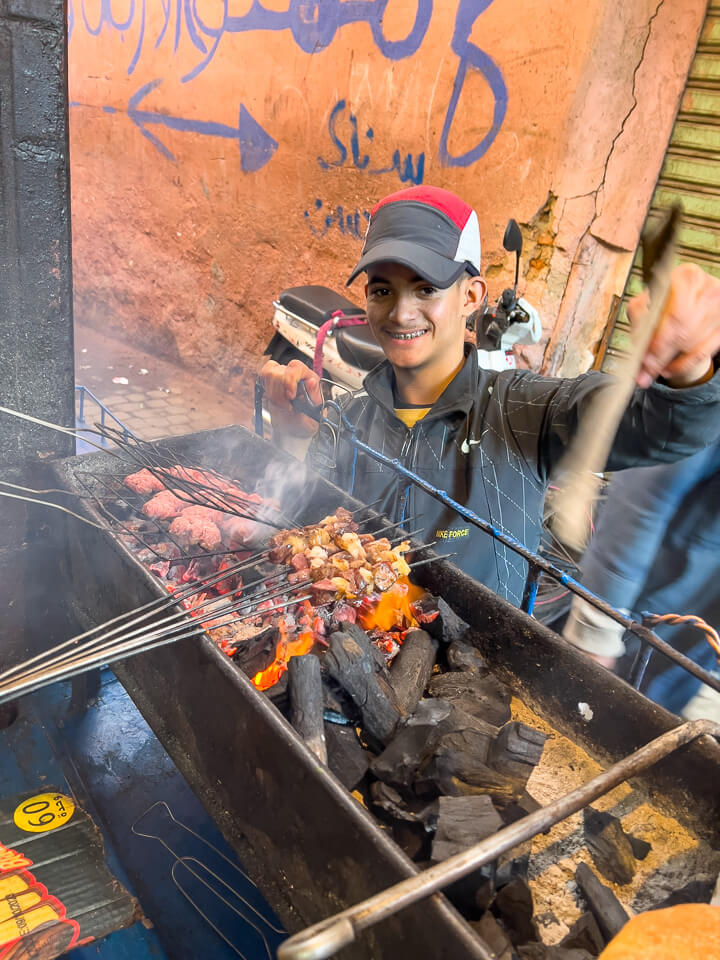
There are barbecue skewers with lamb, beef, chicken or — highly recommended — liver.
If you can get hold of one of the three stools to sit on, you can also enjoy a fresh salad with tomato and onions and flatbread. You can buy water from the kiosk next door.
Or there is meat from the grill platter with tomato and onions in flatbread to take away.
If you are afraid of intestinal problems, simply leave out the fresh ingredients such as tomatoes and onions. A good indicator of quality is always the many locals who buy there.
Cookshops offer the whole variety of Moroccan cuisine
In the midst of all the stores, you will always come across small food stalls selling something to eat. As the eateries are very small, each one specializes in one or two dishes. Here you can eat a soup made from lentils or beans or a flatbread filled with egg and vegetables at a very reasonable price.

These food stalls provide the locals with quick, inexpensive food that is tasty and filling. There are usually one or two tables in the alley and there is a lot of coming and going.
Even if the location doesn’t necessarily meet our standards visually, grilled lamb chops, for example, are unbeatable in terms of taste and you usually have an excellent meal for less than €10 for two.
Sandwiches and filled flatbreads
At the entrance to the Derb Tizougarine alley, where our Riad Selouane is located, Mehdi runs his small sandwich store.
He sells delicious flatbreads freshly filled with chicken and vegetables at his tiny stall.
He also offers vegetarian fillings and everything is fresh and delicious.
You can find small stalls like this scattered all over the medina. Some sell very traditional sandwiches, but sometimes, like at Mehdi’s, you will be really surprised, as there are unusual combinations to discover.
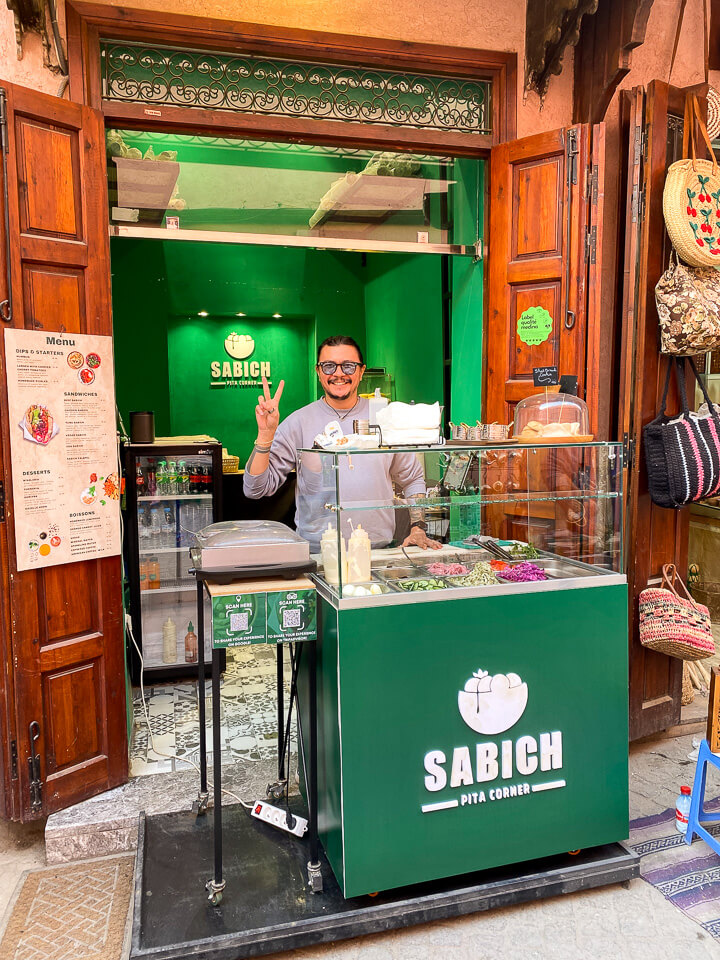
There are many small stalls selling flatbread filled with tomato sauce and boiled egg. The locals use this opportunity to get a quick, inexpensive meal. These flatbreads are also often offered on mobile stalls. When everything is sold, the stall is packed up and closed for the rest of the day.
Specialties
Tagine is probably the Moroccan specialty par excellence. But there is much more to discover and, above all, great regional differences. Marrakesh is particularly famous for its tangia marrakchia, but lamb from the clay oven is also a very special delicacy.
Lamb Mechoui
Near the olive merchants behind the Jemaa el Fna are the restaurants that offer lamb mechoui. This lamb, a specialty of Marrakesh, is cooked for several hours in huge ovens set into the ground.
Sold by weight, the crowds at the start of the sale are huge and the meat is tender as butter.
The lamb is either available to take away or you can eat on site in the restaurant if you can get a seat. There are no plates, everything is served on pieces of paper. The meat is served with flatbread and a mixture of cumin and salt. Very tasty and a truly unusual culinary experience.
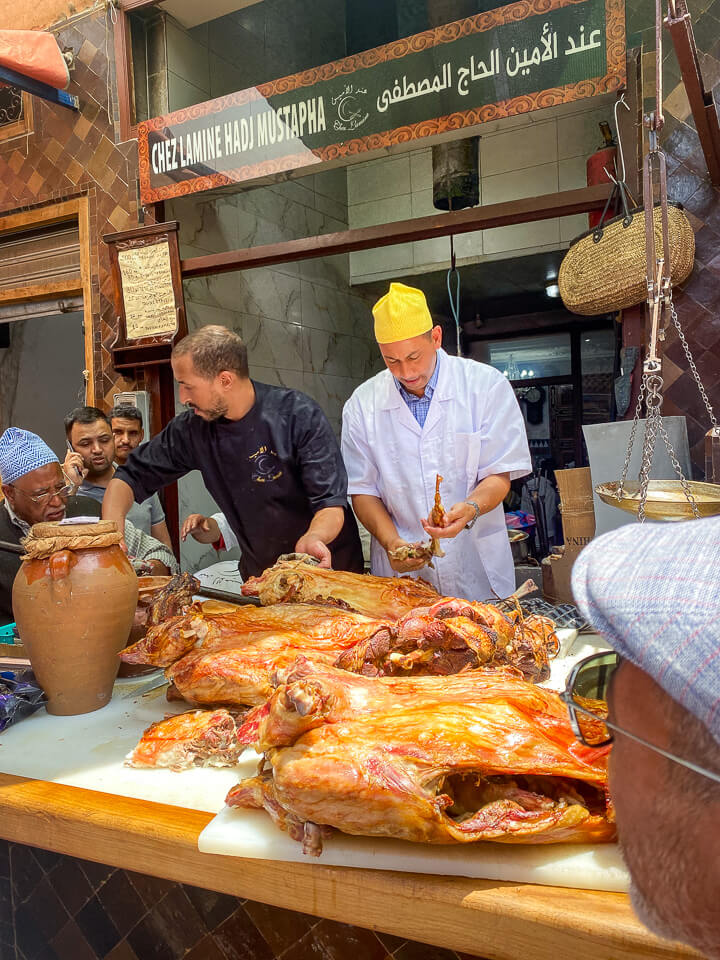
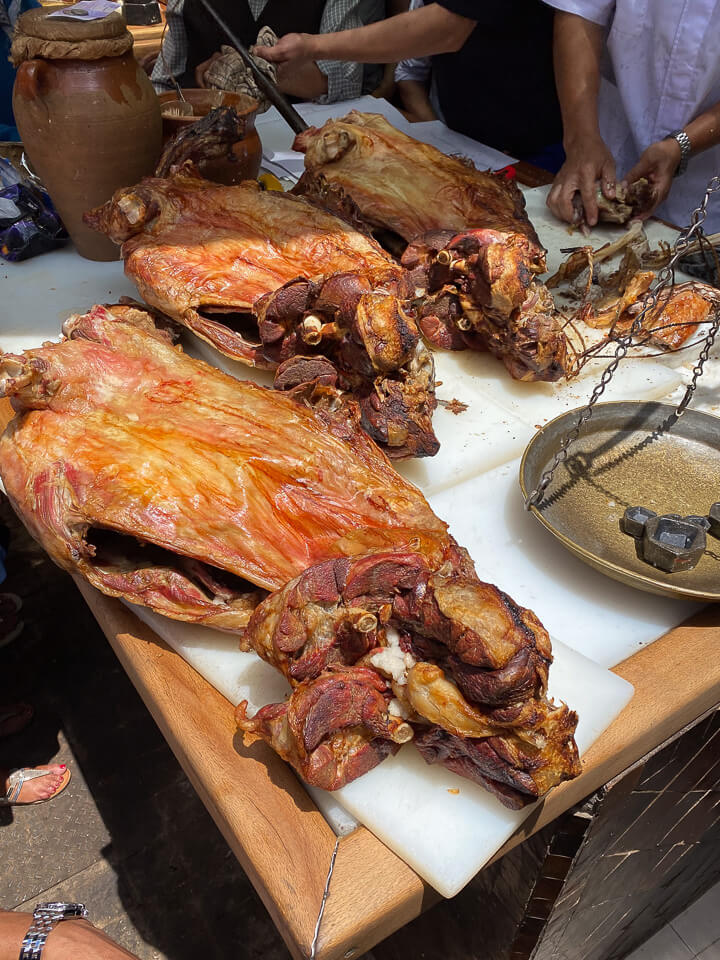
Even if you don’t want to eat here, it’s worth popping in to take a look at the impressive oven and soak up the bustling atmosphere.
Lamb mechoui is only served here at lunchtime, so if you arrive too late, you have to take the unpopular pieces that are the last to go over the counter.
If you would prefer to discover the culinary secrets such as lamb mechoui with a local guide, a guided food tour through Marrakesh* is just the thing for you!
Tangia
In many small restaurants, clay pots are piled up, their glaze showing signs of heavy use.
Tangia, a stew, is prepared in them.
Meat and vegetables are cooked for hours directly in the clay pot and the result is wonderfully tender and highly aromatic. This dish is also served with flatbread.
The price varies depending on the ingredients and the original Tangia Marrakchia with lamb and beef is also served in expensive restaurants. There are usually simpler versions in the souk, but they don’t necessarily taste any worse.
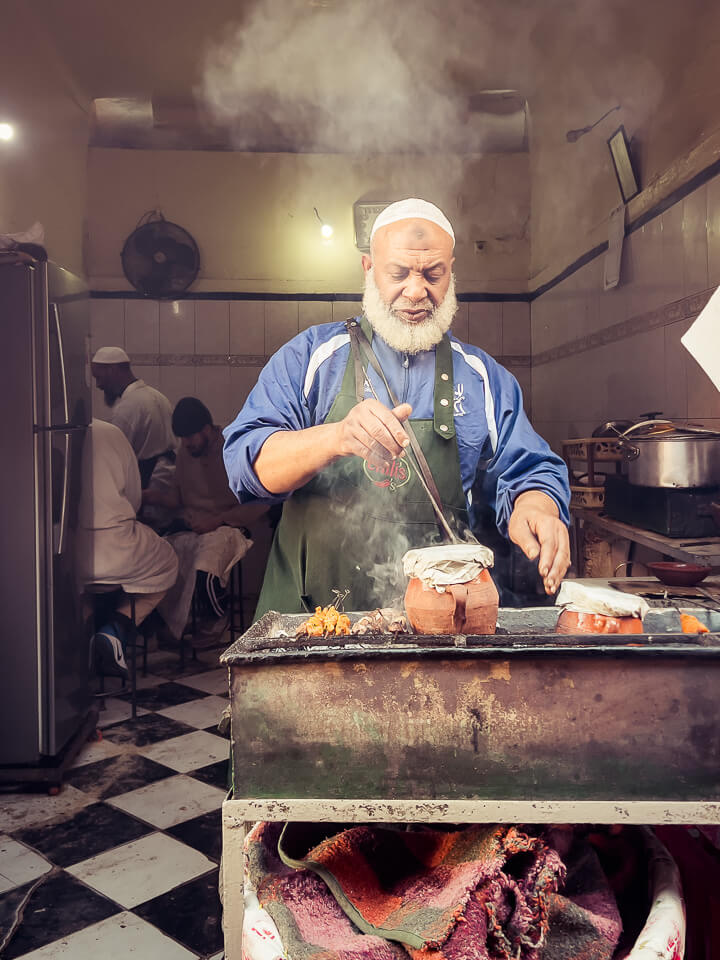
Traditionally, tangia is a real working-class dish: in the morning, the housewife fills her husband’s clay pot with meat and vegetables and he takes it to the souk, where he delivers it to the hammam heater.
The fire that heats the hammam is also used to cook the tangia. For a small fee, the craftsmen let their lunch simmer here before picking it up again at lunchtime and eating it with flatbread.
It is therefore quite possible that an inexpensive tangia in the souk, cooked in the hammam, tastes better than the expensive version in the fancy rooftop restaurant, which was prepared in a normal oven.
Sweets — Patisserie Marocaine
Moroccans love it sweet. You can see this in the mint tea, which seems to have more sugar than tea, and in the honey-dripping sweet pastries that are sold everywhere. In general, all these little delicacies are grouped under the term patisserie marocaine.
Dates and dried fruits
There are several stalls selling dates, nuts and dried fruit on the Jemaa el Fna.
Dates are available loose or pre-packed. They mostly come from the area south of the High Atlas and there are countless varieties.
My favorite is the large Medjoul dates, which are also called dattes royales in Morocco.
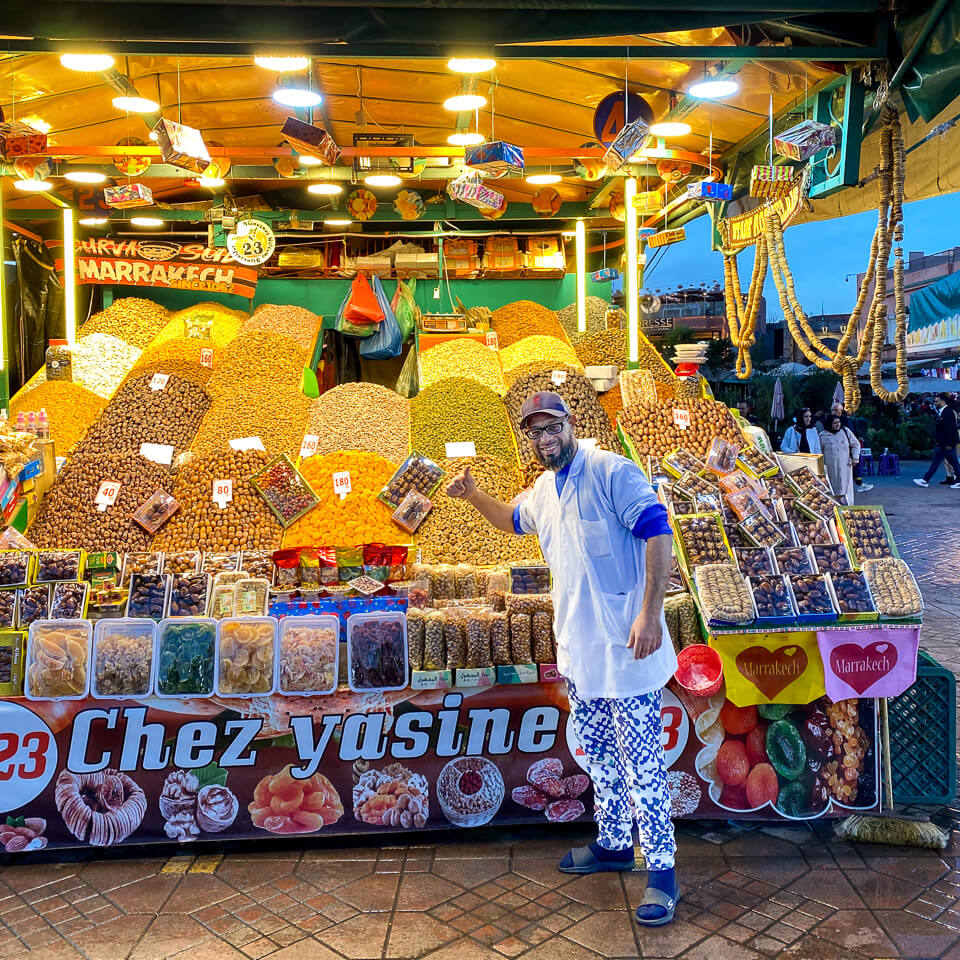
Pastry

There are some impressive stores selling pastries and cookies in the alleyways around Jemaa el Fna.
The vendors are very enterprising, letting visitors try everything and usually selling by weight.
You can also find all kinds of cookies on mobile stalls, especially in the evening on Jemaa el Fna.
In the medina, there are always small pastry shops selling delicious Moroccan cookies and French patisserie. Mille feuille, eclairs, gazelle horns, baklava — the variety is incredible. Sometimes there is a small rooftop terrace where you can enjoy the delicacies while sipping a mint tea.
However, the cookies, which are sold by weight, are usually packed in a cardboard box to take away. These patisseries marocaines are very popular with my family in the evenings on the roof terrace of the riad or as a souvenir to take home.
You can also stumble across mobile stalls selling all kinds of nougat from time to time. The traders are happy to let you try them and some of the flavor combinations are really amazingly delicious.
Some small stalls sell freshly fried Moroccan donuts: sweet, greasy and absolutely popular with the locals. I have never been able to get excited about them. Alone the origin of the frying oil is too suspect for me…
Icecream
Small, stylish stores with colorful cookies and modern flavor combinations are aimed more at tourists. This also applies to the ice cream on a stick, which is colorful, made from delicious fruit juices and tempting on hot days.
In the Hotel Palais Khum and the associated restaurant Babouche — the owners are Italian — there is a small espresso bar open to the street. Here, delicious Illy coffee is served at the counter like in an Italian bar and there is also homemade Italian ice cream in the ice cream cone.
Fancy some street food in Marrakesh?
Our partner GetYourGuide* offers guided food tours, cooking courses and city tours with friendly local guides who will show you the hidden corners of the medina.
Streetfood in Marrakesh is a real experience.
Have the courage to try it!
